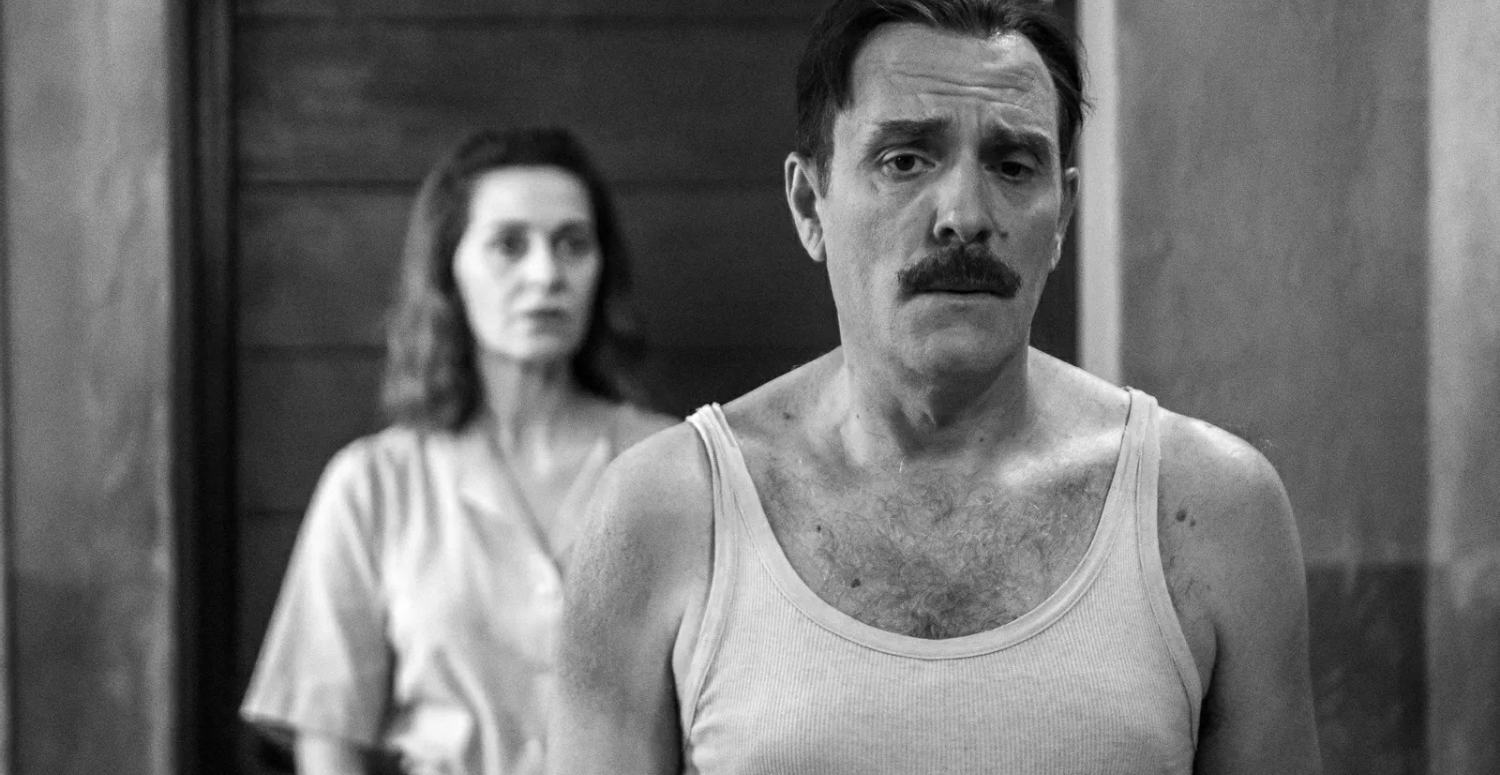Il reste encore demain
C’è ancora domani (There is still tomorrow)
Best First-Time Feature – Italy
Best Original Screenplay – Italy
Best Actress – Italy
Best Supporting Actress – Italy
David Youth Award – Italy
David Audience Award – Italy
2023/2024

FR EN
Long-métrage éminemment politique et diffusé l’automne dernier en Italie en plein cœur de l’affaire du féminicide ultra médiatisé de Giulia Cecchettin, « Il reste encore demain » est non seulement un film au message fort, mais aussi une superbe réalisation et performance de Paola Cortellesi. Dans la Rome de l’immédiat après-guerre, Delia tente de joindre les deux bouts pour élever ses enfants en encaissant tous les coups durs que lui assènent sa vie, son mari et la société.
Tourné en noir et blanc, le long-métrage constitue un hommage envers une époque à la fois meurtrie et pleine d’espoir, dans une Rome à peine libérée par les Alliés et une Italie en plein bouleversement institutionnel. D’une grande théâtralité, les décors comme les personnages nous exposent une ville bouillonnante aux murs et aux habitants hauts en couleurs, ce qui témoigne d’une scénographie réfléchie, où les scènes intérieures comme les plans-séquences fourmillent de détails agréables et astucieux.
Qualifiable de comédie dramatique, « Il reste encore demain » a cette particularité d’alterner et de jouer avec différents tons tout au long de son intrigue, ce qui rend ainsi la trame à la fois légère et sérieuse, nous faisant changer d’humeur (voire nous interrogeant sur comment réagir à certaines situations) à de nombreuses reprises. Citons par exemple cette sensuelle et violente chorégraphie à la fois joviale et glaçante, ou encore cette si romantique et si drôle dégustation de chocolat.
Et justement, la force du film réside dans cet entre-deux (ou plutôt entre-mille) émotionnel qui nous pousse à aller plus loin que ce que pensent les personnages souvent caricaturaux (du grand-père odieux à la bourgeoise pète-sec en passant par la marchande grande gueule) mais tous interprétés avec brio – notamment Marcella (Romana Maggiora Vergano) qui nous électrise de par sa révolte et surtout Delia (Paola Cortellesi) qui nous envoûte de par son endurance. Le choix éclectique des musiques nous invite par ailleurs à outrepasser ces décalages afin de réfléchir plus profondément sur les différents messages de l’intrigue.
Car Delia supporte toutes les tares de la société mais porte aussi toute la puissance des femmes italiennes, capables d’éprouver tout le mal d’un patriarcat abusif et de ne pas s’y résigner en se rebellant subtilement puis prodigieusement, par l’éducation et par la politique. La scène finale jouée sur « A bocca chiusa » forme ainsi une conclusion époustouflante, où les rôles s’inversent et donnent un nouveau souffle à cette Histoire qui donne enfin sa voix à toutes les femmes italiennes d’hier comme d’aujourd’hui. Et même si encore aujourd’hui, toutes ne sont pas émancipées, il reste encore demain pour pouvoir avancer toujours plus dans cette direction.
{English below & Italiano alla fine}
As a highly political feature film released last autumn in Italy in the midst of the much-publicized feminicide of Giulia Cecchettin, “There is still tomorrow” features not only a strong message, but also a brilliant direction and performance by Paola Cortellesi. In post-war Rome, Delia is trying to make ends meet and bring up her children, while taking all the tough hits her life, her husband and society throw at her.
Shot in black-and-white, the film is a tribute to an era both scarred and full of hope, in Rome just liberated by the Allies and Italy in the throes of institutional upheaval. The film’s theatrical sets and characters reveal a bustling city with colorful walls and inhabitants, reflecting a thoughtful set design in which interior scenes and uncut shots teem with delightful, clever details.
Best described as a comedy-drama, “There is still tomorrow” alternates and plays with different tones throughout its plot, making the story both light and serious, changing our moods (and even asking us how to react to certain situations) on numerous occasions. Examples include the sensual and violent choreography, which is both jovial and chilling, or the romantic and funny chocolate tasting.
And precisely, the film’s strength lies in this emotional in-between (or rather in-between thousand), which drives us to go further than the often-caricatured characters (from the obnoxious grandfather through the loud-mouthed shopkeeper to the dry-mouthed bourgeoisie), but all of whom are brilliantly played – notably Marcella (Romana Maggiora Vergano), who electrifies us with her rebelliousness, and above all Delia (Paola Cortellesi), who captivates us with her resilience. The eclectic choice of music also invites us to reach beyond these discrepancies to reflect more deeply on the various messages of the plot.
Delia endures all the ills of society, but also bears all the power of Italian women, capable of experiencing all the evils of an abusive patriarchy and of resisting them by subtly, then prodigiously, rebelling through education and politics. The final scene, to the tune of “A bocca chiusa”, provides a breathtaking conclusion, where the roles are reversed, giving a fresh perspective to this story that finally gives a voice to all Italian women, past and present. And even though not all of them are emancipated to this day, there’s still tomorrow to take us further down that path.
Axel Chevalier
(Translation by R.S.)
ITALIANO
Uscito lo scorso autunno in Italia nel pieno del caso del femminicidio di Giulia Cecchettin, “C’è ancora domani” non è solo un film con un messaggio forte, ma anche una superba regia e interpretazione di Paola Cortellesi. Nella Roma del dopoguerra, Delia cerca di sbarcare il lunario e di crescere i suoi figli, subendo tutti i colpi duri che la vita, il marito e la società le riservano.
Girato in bianco e nero, il film è un omaggio a un’epoca segnata e allo stesso tempo piena di speranze, in una Roma appena liberata dagli Alleati e in un’Italia in preda agli sconvolgimenti istituzionali. Le scenografie e i personaggi del lungometraggio ci mostrano una città vivace, con muri e abitanti colorati, a testimonianza di un’accurata scenografia, con scene interne e piani-sequenze ricchi di dettagli piacevoli e intelligenti.
Descritto come una drammedia, “C’è ancora domani” alterna e gioca con diversi toni nel corso della sua trama, rendendo la storia sia leggera che seria, cambiando il nostro stato d’animo (e chiedendoci anche come reagire di fronte a certe situazioni) in numerose occasioni. Citiamo ad esempio questa coreografia sensuale e violenta, gioviale e agghiacciante al tempo stesso, e questa buffa e romantica degustazione di cioccolato.
Ed appunto, la forza del film sta proprio in questa via di mezzo emotiva che ci spinge a spingerci più in là di quanto pensino i personaggi spesso caricaturali (dal nonno antipatico alla borghese vanitosa e la negoziante sbruffone), ma tutti brillantemente interpretati–in particolare Marcella (Romana Maggiora Vergano), che ci elettrizza con la sua ribellione, e soprattutto Delia (Paola Cortellesi), che ci affascina con la sua resistenza. La scelta eclettica delle musiche ci invita altresì a guardare oltre queste discrepanze per riflettere più profondamente sui vari messaggi della trama.
Delia, infatti, sopporta tutti i difetti della società, ma porta anche tutta la forza delle donne italiane, capaci di sentire tutto il male di un patriarcato abusivo e di non rassegnarsi ad esso, ribellandosi sottilmente e poi prodigiosamente, attraverso l’educazione e la politica. La scena finale, sulle note di “A bocca chiusa”, è una conclusione mozzafiato in cui i ruoli si invertono, dando nuova vita a una storia che finalmente dà voce a tutte le donne italiane, del passato e del presente. E anche se oggi non tutte sono emancipate, c’è ancora domani per portarci avanti in quella direzione.
Axel Chevalier
(Traduzione di A.C.)

